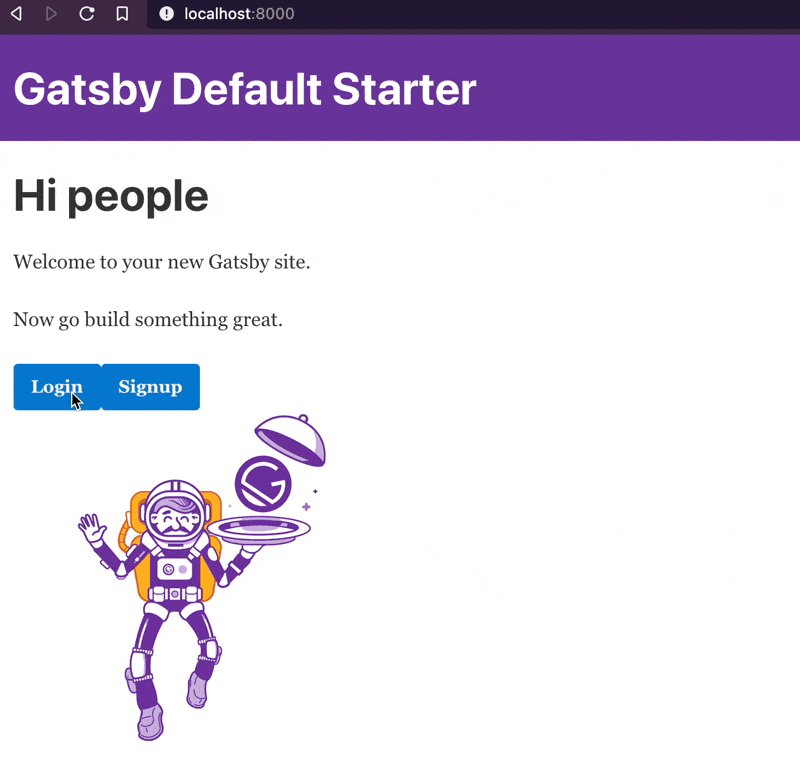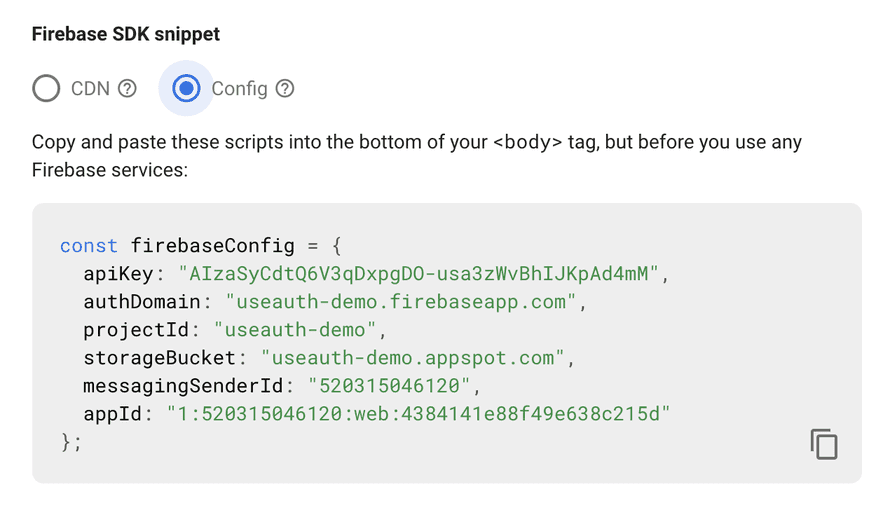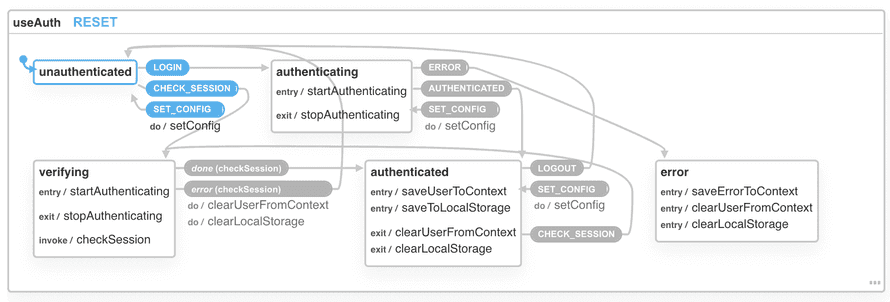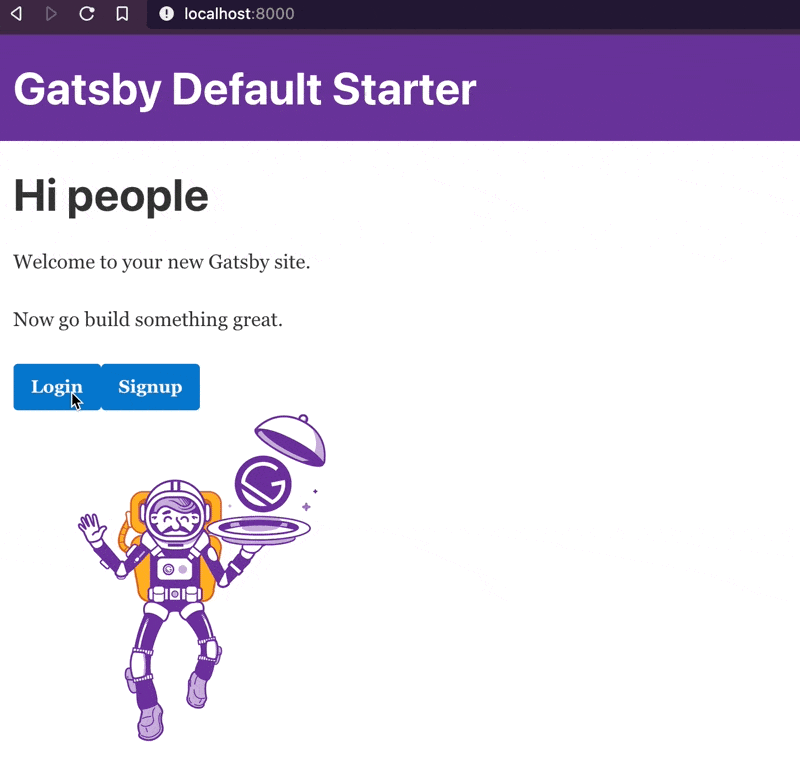It works! useAuth has beta-level support for Firebase Auth 🥳 I did not expect that to take 3 sessions.

Are you a Firebase user? Can you please try it out and tell me what's missing. It would mean a lot ❤️
CodeWithSwiz is a weekly live show. Like a podcast with video and fun hacking. Focused on experiments and open source. Join live Mondays
We got to a working proof of concept in last week's episode. Rough UI, transitions bad, state machines not synced, and we knew it worked because console.log spat out a user.
Encouraging but not useful.
This episode was about polishing that turd into a useful beta. Improve the config experience, sync Firebase's and useAuth's state machines, recover sessions on page load, tighten up TypeScript types.
And as a bonus, we ran into ye olde this problem. Thought those days were behind me 🥲
Improve the config experience
You want to reduce moving parts while prototyping. Make sure you can move fast and ignore fiddly details.
Hardcoding config is a time-honored tradition. A great way to leak your API keys on GitHub and get an AWS account shut down, too.
Here's how it works now:
// as a user
<AuthConfig
authProvider={FirebaseUI}
navigate={navigate}
params={{
// Firebase standard practice to copypasta this blob?
firebaseConfig: {
apiKey: "AIzaSyCdtQ6V3qDxpgDO-usa3zWvBhIJKpAd4mM",
authDomain: "useauth-demo.firebaseapp.com",
projectId: "useauth-demo",
storageBucket: "useauth-demo.appspot.com",
messagingSenderId: "520315046120",
appId: "1:520315046120:web:4384141e88f49e638c215d",
},
}}
/>
Reading Firebase docs, it sounds like copy-pasting your firebaseConfig object is standard practice. Go into the dashboard, click a button, paste into your project.

Keeping things familiar so users don't get scared ✌️
Passing an initialized app
You might have a Firebase app in your stack already. For authentication or otherwise.
When you pass firebaseConfig useAuth initializes a new app for itself. That might not be a good idea.
Instead, you can pass an existing initialized firebase app.
// as a user
<AuthConfig
authProvider={FirebaseUI}
navigate={navigate}
params={{
// pass initialized app
firebaseApp: Firebase,
}}
/>
A conditional in FirebaseUI takes the params object and decides which path to take.
// src/providers/FirebaseUI.ts
if (params.firebaseConfig) {
this.firebase = Firebase.initializeApp(params.firebaseConfig, "useAuth")
} else if (params.firebaseApp) {
this.firebase = params.firebaseApp
} else {
throw "Please provide firebaseConfig or initialized firebaseApp"
}
If there's no config, we throw an error. I hope it's a helpful error ... wish I knew how to encode that in TypeScript. Feels like the type system should enforce conditionally optional params 🤔
Sync Firebase's and useAuth's state machines
You can think of Firebase and useAuth as 2 state machines running side by side. Firebase keeps track of user state, useAuth wants to keep track of user state.

Syncing state machines is a notoriously difficult problem. You try to figure it out and after 3 days you say "Damn it, why didn't I read a book first?"
Your best bet is the observer pattern. If the target state machine supports it. Otherwise the actor model works fine.
You end up with a system like this:
- useAuth subscribes to Firebase
- User does a thing
- Firebase changes state
- Firebase tells useAuth
- useAuth changes state
- useAuth hook updates return values
- React re-renders affected components
Two machines weakly communicating through events, independently changing their internal state. 🤘
In code you get this:
// src/providers/FirebaseUI.ts
constructor(params: AuthOptions & FirebaseOptions) {
// ...
// Auth state observer
this.firebase
.auth()
.onAuthStateChanged(this.onAuthStateChanged.bind(this));
}
private onAuthStateChanged(user: Firebase.User | null) {
if (user) {
this.dispatch("LOGIN");
this.dispatch("AUTHENTICATED", {
user: this.firebase.auth().currentUser,
authResult: {
// needed for useAuth to work
expiresIn: 3600
}
});
}
}
We subscribe to auth changes with a callback function. The function checks for a user, if one is present, it goes through useAuth events to log you in.
We dispatch the LOGIN and AUTHENTICATED events because XState doesn't allow jumping ahead. As it shouldn't. But we don't know when this code runs – could be on init before we start logging in.
Might need to dispatch LOGOUT when there's no user 🤔
Recover sessions on page load
useAuth has built-in support for validating user sessions on page load. That's like a core value prop.
To make that happen, it uses a side-effect to call a checkSession function on the auth provider. That method is meant to phone home, check your cookies, whatever it needs to decide "Is the current user still the current user?"
Firebase makes that part pretty okay:
public async checkSession(): Promise<{
user: AuthUser;
authResult: Auth0DecodedHash;
}> {
// verify session is still valid
// return fresh user info
const user = this.firebase.auth().currentUser;
if (user) {
// throws if user no longer valid
await user.reload();
return {
user,
authResult: {
// needed for useAuth to work
expiresIn: 3600
}
};
} else {
throw new Error("Session invalid");
}
}
Grab the current user from Firebase, reload their info, return user object and fake an expiresIn timer to keep useAuth happy.
I considered storing the user.toJSON() version of the user object, but that strips away Firebase methods. Figured people used to Firebase would want to keep those.
Although the object is gnarly as heck ...
Wow when Firebase returns the authenticated user in a callback ... I guess *some* of those are user properties 🤨 pic.twitter.com/0jtGUgjrGI
— Swizec Teller (@Swizec) January 19, 2021
The dreaded this
This part.
// Auth state observer
this.firebase.auth().onAuthStateChanged(this.onAuthStateChanged.bind(this))
Bloody hell I can't remember the last time I had to manually bind a function to its object. Nice reminder that class FirebaseUI {} is syntax sugar for dark magic from 2010.
Forget to bind and onAuthStateChanged doesn't know which object it belongs to when called as a callback. Throws cryptic errors. 🙃

🎉
And we got a working beta version.

But I don't know what's missing. Need to play around more, try different configurations and authentication modes. Figure out how to make developer experience better
Are you a Firebase user? Can you please try it out and tell me what's missing. It would mean a lot ❤️
Cheers,
~Swizec
Continue reading about [CodeWithSwiz 21] useAuth beta support for Firebase 🎉
Semantically similar articles hand-picked by GPT-4
- [CodeWithSwiz 19] Firebase Auth support in useAuth, pt1
- [CodeWithSwiz 20] Adding Firebase support to useAuth, pt2
- React context without context, using XState – CodeWithSwiz 14, 15
- useAuth – the simplest way to add authentication to your React app
- How to write tests for XState – CodeWithSwiz 12
Learned something new?
Read more Software Engineering Lessons from Production
I write articles with real insight into the career and skills of a modern software engineer. "Raw and honest from the heart!" as one reader described them. Fueled by lessons learned over 20 years of building production code for side-projects, small businesses, and hyper growth startups. Both successful and not.
Subscribe below 👇
Software Engineering Lessons from Production
Join Swizec's Newsletter and get insightful emails 💌 on mindsets, tactics, and technical skills for your career. Real lessons from building production software. No bullshit.
"Man, love your simple writing! Yours is the only newsletter I open and only blog that I give a fuck to read & scroll till the end. And wow always take away lessons with me. Inspiring! And very relatable. 👌"
Have a burning question that you think I can answer? Hit me up on twitter and I'll do my best.
Who am I and who do I help? I'm Swizec Teller and I turn coders into engineers with "Raw and honest from the heart!" writing. No bullshit. Real insights into the career and skills of a modern software engineer.
Want to become a true senior engineer? Take ownership, have autonomy, and be a force multiplier on your team. The Senior Engineer Mindset ebook can help 👉 swizec.com/senior-mindset. These are the shifts in mindset that unlocked my career.
Curious about Serverless and the modern backend? Check out Serverless Handbook, for frontend engineers 👉 ServerlessHandbook.dev
Want to Stop copy pasting D3 examples and create data visualizations of your own? Learn how to build scalable dataviz React components your whole team can understand with React for Data Visualization
Want to get my best emails on JavaScript, React, Serverless, Fullstack Web, or Indie Hacking? Check out swizec.com/collections
Did someone amazing share this letter with you? Wonderful! You can sign up for my weekly letters for software engineers on their path to greatness, here: swizec.com/blog
Want to brush up on your modern JavaScript syntax? Check out my interactive cheatsheet: es6cheatsheet.com
By the way, just in case no one has told you it yet today: I love and appreciate you for who you are ❤️
